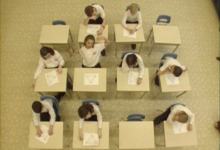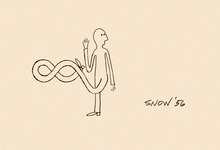- Images (8)
- Links (0)
- Agenda (0)

|

|

|

|

|

|

|

|

|

|

|

|

|

|

|

|

|
by Michael SNOW
2001 / Video / color / sound / 1 screen / 92' 00 |
The Corpus Callosum is a central region of tissue in the human brain which passes »messages» between the two hemispheres.
My hemispheres thought that * Corpus Callosum was an appropriate title because the film is about, or shows, «betweens.»
The facts of visible life are its basis, basic stuff: people are male or female, some (mostly men) are tall, some (mostly women and children) are small, but there are also dwarfs and hermaphrodites, people may be very fat or very thin, there are discernible races, there is blonde hair, black hair, red hair (but hair can be dyed or wigs may be worn and there is baldness too.
Corpus Callosum juxtaposes or counterpoints a realism of normal metamorphosis (two extreme examples: pregnancy, explosions) in believable, «real» interior spaces with «impossible» shape changes (some made possible with digital animation).
First the camera, then we in the audience, observe the observations of the «real» people depicted in the obviously staged situations. What we see and what they «see» is involved in shifting modes of belief.
There seem to be (though there is no narrative) a Hero and Heroine. However, from scene to scene they are different people costumed identically or altered electronically.
The film is tableaux of transformation, a tragi-comedy of the cinematic variable.
The sound - electronic like the picture - is also a continuous metamorphosis and as the film's «nervous system,» is as important to the film as the picture. Or: the sound and the picture are two hemispheres joined by the artist.
*Corpus Callosum is resolutely «artificial,» it not only wants to convince, but also to be a perceived pictorial and musical phenomenon.
Two propositions: Video is a sense, not «optical.» Video has an inherent instability, alterability and melleability. With digital anmation one can change shapes pixel by pixel, something that was not possible with film.
The «effects» in * Corpus Callosum were consructed by computer animation using Houdini, a software by a team led by Greg Hermanovic, who was the animation consultant for the film.
In our world, motion exists between two periods of rest. In film panning and trucking shots (where the present is continually, visibly, becoming the past and the future). The trucking is definedby «holds»: abnormal stasis where examination is asked for by the stationary monocular camera.
To over-generalize: in each of my films since 1963 i have concentrated on some particular possibility, special or specific to the medium, with the goal or hope that the experience of the spectator would involve a consciousness of the «specialness» of their stimuli. For example, New-York Eye and Ear Control (1964) and Rameau's Nephew ... (1975) concentrated each in a different way on image-sound relations. Wavelenght (1967), first of a set of films that foregrounded camera motion, put the spectator in a zoom. Back and Forth (1969) is build on panning, as is in a more complicated way, La Region Centrale. (1971). To Lavoisier ... (1993) used the photo-chemical facts of photography. See you later / Au Revoir (1990) is a very slow motion pan.
Corpus Callosum involves transformations or metamorphoses. Some of what is seen in it would not have been possible before digital computer animation. The on/off principe is featured too.
I had used video manipulation in the «Lecture» scene in Rameau's Nephew ... but most importantly for the genesis of * Corpus Callosum , in the opening scene of Presents (1981) i used a Quantel process (at the time, a television way of maling «wipes» between scenes) to compress and elongate the image. I'd previuosly done some modest experiments using prisms to disort an image, but seeing the compression and elongation in Present set off fifteen years of notations of ideas for the possible squeezing-and-streching film. Twenty pages of these scribbled ideas were published in 1993 by a Paris magazine called Poliphile.
But in a sense, work on * Corpus Callosum started in 1956. A sequence of drawn animation showing a man's leg stretching strangely, which i did then, closes the film.
Except for the three minutes ending, the film is entirely live-action. The first of this footage was staged and shot in 1997. The film was completely scripted.
In 2000 i exhibited a 20-minute film entitled The Living Room. This continues to exist as an independant work but is now (as originally intended) a part of the 92-minute * Corpus Callosum.
Michael Snow
Toronto/December
| distribution format | Digital file on server (PAL) |
|---|---|
| screen | 4/3 (single screen) |
| speed | 25 fps |
| sound | sound |
| original language | English |
| rental fee | 245,00 € |